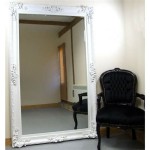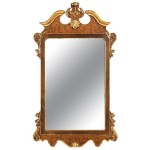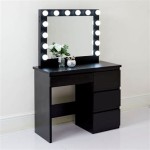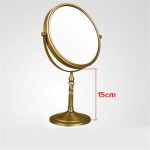Mid-Century Mirrors: Reflections of a Design Era
Mid-century modern design, a style heavily influenced by post-World War II optimism and technological advancements, flourished from roughly the mid-1940s to the late 1960s. This era saw a significant shift towards clean lines, functionality, and the use of new materials. Furniture, architecture, and decorative accessories all embraced this aesthetic, and mirrors were no exception. Mid-century mirrors served not only a practical purpose but also acted as key decorative elements, reflecting light and enhancing the overall ambiance of a space.
The design principles of the mid-century modern movement heavily influenced mirror design. The focus was on simplicity, organic shapes, and a lack of excessive ornamentation. Mirrors from this period often feature streamlined frames, geometric forms, and an emphasis on the materials themselves. Walnut, teak, and other natural woods were frequently used for frames, highlighting the appreciation for natural beauty. Metal frames, often in brass or chrome, were also popular, reflecting the era's fascination with industrial materials and sleek, modern aesthetics.
Beyond their aesthetic appeal, mid-century mirrors played a crucial role in interior design. They were strategically placed to maximize natural light, creating an illusion of spaciousness, particularly in smaller homes and apartments that were characteristic of the postwar housing boom. The use of mirrors allowed architects and designers to visually expand rooms, brighten dark corners, and enhance the overall sense of airiness and openness. The placement was less about purely decorative embellishment and more about using the mirror to actively shape the perceived dimensions and light quality of a room.
Key Characteristics of Mid-Century Modern Mirrors
Identifying a true mid-century modern mirror requires understanding the defining features of the era's design aesthetic. These characteristics are not always present in every piece, but they serve as helpful indicators when assessing the authenticity and style of a mirror.
Clean Lines and Geometric Shapes: One of the most prevalent indicators of a mid-century modern mirror is its emphasis on clean lines and geometric shapes. This aligns with the broader design movement's rejection of ornate Victorian styles and its embrace of simplified forms. Mirrors might feature rectangular, square, oval, or circular shapes, often with sharp angles and smooth surfaces. The focus is on the purity of the form, without unnecessary embellishment. Frames are typically minimal, allowing the shape itself to take center stage. This geometric focus often extends to arrangements as well, with groupings of smaller, geometrically shaped mirrors used to create larger wall installations.
Emphasis on Natural Materials: The mid-century modern era celebrated natural materials, and this is evident in the mirror designs of the time. Wood, particularly walnut, teak, and other hardwoods, was a popular choice for frames. The natural grain and warmth of the wood were often highlighted, showcasing the inherent beauty of the material. Metal frames, typically brass or chrome, were also utilized, reflecting the industrial influences of the era. These metals were often polished to a high shine, adding a touch of glamour and sophistication to the design. The combination of natural and man-made materials was a common theme, embodying the era's blend of organic and modern sensibilities. The choice of materials was also often dictated by practicality and durability, prioritizing long-lasting pieces that could withstand daily use.
Minimalist Framing and Ornamentation: In stark contrast to earlier design periods, mid-century modern mirrors embraced minimalism in framing and ornamentation. Extraneous details were deliberately avoided, focusing instead on the essential form and function of the mirror. Frames were often thin and understated, made from wood or metal, and designed to complement rather than dominate the mirror itself. Any embellishments, if present at all, were typically subtle and geometric, such as simple inset patterns or a slight bevel on the glass. The goal was to create a clean, uncluttered look that would seamlessly integrate into a modern interior. This minimalist approach reflects the broader mid-century modern philosophy of "less is more," prioritizing functionality and simplicity over ostentation.
Popular Styles and Designs
Within the broader category of mid-century modern mirrors, several distinct styles and designs emerged. These variations reflect different interpretations of the era's aesthetic, catering to diverse tastes and interior design preferences.
Starburst Mirrors: Perhaps one of the most iconic and recognizable mid-century modern mirror styles is the starburst mirror. These mirrors feature a central circular mirror surrounded by radiating "rays" made of metal, wood, or a combination of materials. The rays are often arranged in a symmetrical pattern, resembling a stylized sun or star. Starburst mirrors were designed to be eye-catching focal points, adding a touch of glamour and drama to a room. They were often placed above fireplaces, sofas, or consoles, serving as a bold statement piece. The reflective surfaces of the rays amplified light and created a dynamic visual effect. The style became synonymous with the exuberance and optimism of the mid-century era.
Atomic Mirrors: Another popular style, atomic mirrors, drew inspiration from the atomic age and the era's fascination with science and technology. These mirrors often feature asymmetrical shapes, angular lines, and abstract patterns. The designs were inspired by atomic models and diagrams, reflecting the scientific advancements of the time. Materials used included metal, wood, and sometimes even colored plastic. Atomic mirrors were typically smaller than starburst mirrors and were often grouped together to create larger wall installations. Their unique and unconventional designs added a sense of playfulness and modernity to interiors, reflecting the era's forward-thinking spirit.
Teak Framed Mirrors: Teak, prized for its durability, rich color, and beautiful grain, was a favored material in mid-century modern furniture and accessories, including mirrors. Teak framed mirrors typically featured clean, simple lines and a natural finish, showcasing the wood's inherent beauty. The warmth of the teak wood complemented the reflective surface of the mirror, creating a harmonious and inviting aesthetic. These mirrors were often rectangular or oval in shape and were popular for use in bathrooms, bedrooms, and living rooms. The natural durability of teak made these mirrors suitable for a variety of environments, ensuring their longevity and enduring appeal. The focus was on highlighting the inherent qualities of the wood, rather than concealing it beneath layers of paint or varnish.
The Enduring Appeal of Mid-Century Modern Mirrors
Despite their origins in the mid-20th century, mid-century modern mirrors continue to be highly sought after by collectors, designers, and homeowners alike. Their enduring appeal can be attributed to several factors.
Timeless Design: The clean lines, simple forms, and use of natural materials characteristic of mid-century modern design have proven to be remarkably timeless. These mirrors seamlessly integrate into a variety of interior styles, from minimalist and contemporary to eclectic and bohemian. Their versatility allows them to be used in different rooms and settings, adding a touch of understated elegance to any space.
Functional Art: Mid-century modern mirrors are not just functional objects; they are also works of art. Their carefully considered designs, quality craftsmanship, and unique artistic expressions elevate them beyond mere utilitarian items. They serve as decorative focal points, adding visual interest and personality to a room. The reflective surfaces enhance light and create a sense of spaciousness, further contributing to their aesthetic value.
Investment Value: Original mid-century modern mirrors, particularly those designed by renowned designers or manufactured by well-known companies, can be valuable investments. As these pieces become increasingly rare and sought after, their value tends to appreciate over time. Collecting mid-century modern mirrors can be a rewarding hobby, combining aesthetic appreciation with potential financial gain. However, it's crucial to research thoroughly and authenticate pieces before making a purchase to ensure their authenticity and value.
In conclusion, mid-century modern mirrors represent a significant chapter in design history. They embody the aesthetic principles of the era, reflecting a focus on simplicity, functionality, and the use of natural materials. Their enduring appeal lies in their timeless design, functional artistry, and potential investment value. By understanding the key characteristics and popular styles of mid-century modern mirrors, enthusiasts can appreciate their beauty and historical significance, making informed decisions when collecting or incorporating them into their own spaces.

Mid Century Modern Mirror Geometric Wall Large

Wallbeyond Mid Century Asymmetrical 20 In W X 25 H Wood Brown Satin Wall Mirror 342103 The Home Depot

Mid Century Asymmetrical Wood Wall Mirror 14 Cm X 103 129 West Elm

Mid Century Asymmetrical Floor Mirror West Elm

Mid Century Asymmetrical Wall Mirror West Elm Modern House Decor
:strip_icc()/cdn.cliqueinc.com__cache__posts__262916__midcentury-modern-mirrors-262916-1531442364113-main.700x0c-7879f4f4ff58442ea8bac9743b6a3c76.jpg?strip=all)
Midcentury Modern Mirrors To Make Your Room Look Bigger

10 Mid Century Modern Mirrors To Your Interior Designs Unique Blog

Mid Century Modern Mirror For Wall Décor Ornate Small

Furniture Tips The Best Mid Century Mirrors

Mid Century Asymmetrical Metal Wall Mirror 99 Cm W X 114 H West Elm








